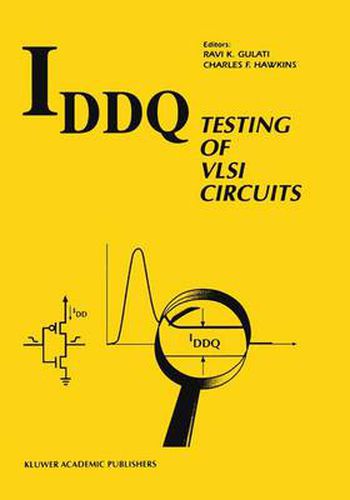Readings Newsletter
Become a Readings Member to make your shopping experience even easier.
Sign in or sign up for free!
You’re not far away from qualifying for FREE standard shipping within Australia
You’ve qualified for FREE standard shipping within Australia
The cart is loading…






This title is printed to order. This book may have been self-published. If so, we cannot guarantee the quality of the content. In the main most books will have gone through the editing process however some may not. We therefore suggest that you be aware of this before ordering this book. If in doubt check either the author or publisher’s details as we are unable to accept any returns unless they are faulty. Please contact us if you have any questions.
Power supply current monitoring to detect CMOS IC defects during production testing quietly laid down its roots in the mid-1970s. Both Sandia Labs and RCA in the United States and Philips Labs in the Netherlands practiced this procedure on their CMOS ICs. At that time, this practice stemmed simply from an intuitive sense that CMOS ICs showing abnormal quiescent power supply current (IDDQ) contained defects. Later, this intuition was supported by data and analysis in the 1980s by Levi (RACD, Malaiya and Su (SUNY-Binghamton), Soden and Hawkins (Sandia Labs and the University of New Mexico), Jacomino and co-workers (Laboratoire d'Automatique de Grenoble), and Maly and co-workers (Carnegie Mellon University). Interest in IDDQ testing has advanced beyond the data reported in the 1980s and is now focused on applications and evaluations involving larger volumes of ICs that improve quality beyond what can be achieved by previous conventional means. In the conventional style of testing one attempts to propagate the logic states of the suspended nodes to primary outputs. This is done for all or most nodes of the circuit. For sequential circuits, in particular, the complexity of finding suitable tests is very high. In comparison, the IDDQ test does not observe the logic states, but measures the integrated current that leaks through all gates. In other words, it is like measuring a patient’s temperature to determine the state of health. Despite perceived advantages, during the years that followed its initial announcements, skepticism about the practicality of IDDQ testing prevailed. The idea, however, provided a great opportunity to researchers. New results on test generation, fault simulation, design for testability, built-in self-test, and diagnosis for this style of testing have since been reported. After a decade of research, we are definitely closer to practice.
$9.00 standard shipping within Australia
FREE standard shipping within Australia for orders over $100.00
Express & International shipping calculated at checkout
This title is printed to order. This book may have been self-published. If so, we cannot guarantee the quality of the content. In the main most books will have gone through the editing process however some may not. We therefore suggest that you be aware of this before ordering this book. If in doubt check either the author or publisher’s details as we are unable to accept any returns unless they are faulty. Please contact us if you have any questions.
Power supply current monitoring to detect CMOS IC defects during production testing quietly laid down its roots in the mid-1970s. Both Sandia Labs and RCA in the United States and Philips Labs in the Netherlands practiced this procedure on their CMOS ICs. At that time, this practice stemmed simply from an intuitive sense that CMOS ICs showing abnormal quiescent power supply current (IDDQ) contained defects. Later, this intuition was supported by data and analysis in the 1980s by Levi (RACD, Malaiya and Su (SUNY-Binghamton), Soden and Hawkins (Sandia Labs and the University of New Mexico), Jacomino and co-workers (Laboratoire d'Automatique de Grenoble), and Maly and co-workers (Carnegie Mellon University). Interest in IDDQ testing has advanced beyond the data reported in the 1980s and is now focused on applications and evaluations involving larger volumes of ICs that improve quality beyond what can be achieved by previous conventional means. In the conventional style of testing one attempts to propagate the logic states of the suspended nodes to primary outputs. This is done for all or most nodes of the circuit. For sequential circuits, in particular, the complexity of finding suitable tests is very high. In comparison, the IDDQ test does not observe the logic states, but measures the integrated current that leaks through all gates. In other words, it is like measuring a patient’s temperature to determine the state of health. Despite perceived advantages, during the years that followed its initial announcements, skepticism about the practicality of IDDQ testing prevailed. The idea, however, provided a great opportunity to researchers. New results on test generation, fault simulation, design for testability, built-in self-test, and diagnosis for this style of testing have since been reported. After a decade of research, we are definitely closer to practice.